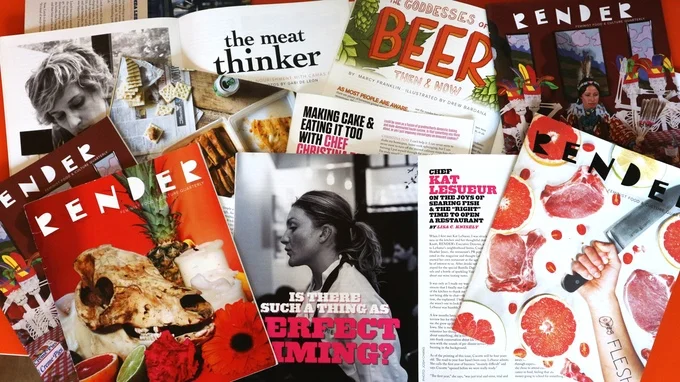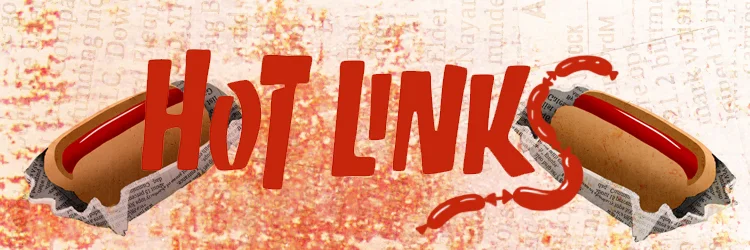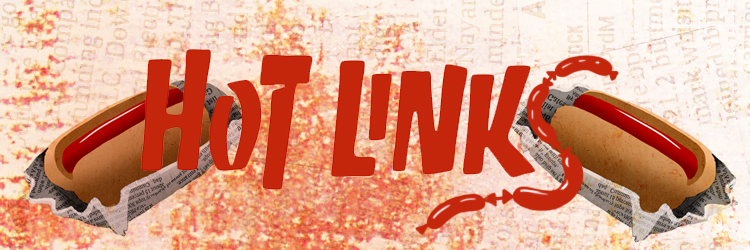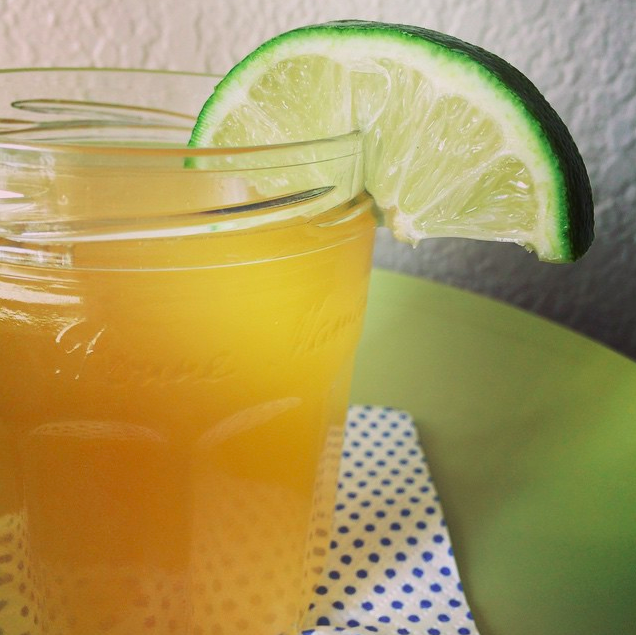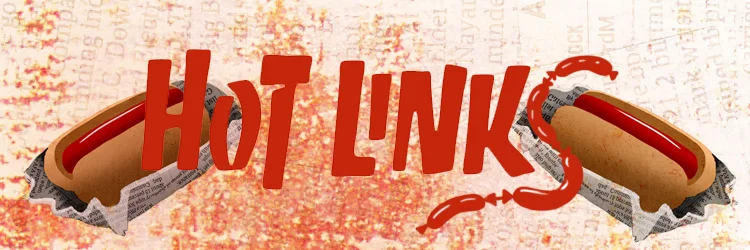Lauren Garaventa. All images courtesy of Lauren.
RENDER's Editor-in-Chief, Lisa Knisely, sat down with butcher Lauren Garaventa for a chat. It wasn't long before they were geeking out about eating chicken feet and how good beef heart tastes.
Lisa Knisely: Tell me about how long you’ve been a butcher and what brought you to butchering as a profession.
Lauren Garaventa: I have always been really interested in food, but I didn’t know how I wanted to bring that into my life and make it a part of what I was doing. So, I just started trying to really think about what my favorite things to eat were and definitely cured meats is one of my favorite things to eat. I figured if I learned how to make it, I’d always be able to eat it. So, I started just curing meat and then that translated into where the meat comes from, and how it’s raised and how it’s handled. I just decided I wanted to be a part of all that, and so I started cutting meat and then moved to [Vashon] Island to start raising my own animals.
LCK: You have your own farm?
LG: Yes, we have a farm where we raise pigs and cows and sheep.
LCK: What were you doing before farming and butchery?
LG: I was a tour manager for bands. I used to go on tour with punk bands.
LCK: Did you or anyone in your family have any background in farming or butchery? Or was this a totally left field thing for you to do?
LG: My parents were always pretty food conscious...you know, we were part of a cop-op...I knew about food and ingredients and how important it was to grow things yourself and get them from farmers, but I had never really put it fully into practice. But, no, no one else in my family works in food or anything like that.
LCK: And what about Meat and Noodle? How does that work?
LG: It’s a soup supper club that happens at least one Sunday a month. It’s a way for me to use all the bones from our animals and utilize vegetables from the island. It’s a way for me to feed people and a way for me to use the whole animal – even skin, or feet, or the head, or the – to turn it into good food to feed the people on Vashon.
LCK: How do you feel you gender has influenced your job, if at all?
LG: Well, it was definitely hard for me to get a job to work to be a butcher, I can say. I don’t know for sure if that’s because I’m a woman, but it felt like it. It took me a year and a half just to even get an internship. I didn’t have a lot of experience and I didn’t want to touch factory meat. Finding a place where I could intensively learn butchery and have someone teach me took a long time. I had one shop tell me that they would only hire a woman they were related to. I’ve worked in butcher’s shops in Seattle where people just assume I’m a server or something else, even when I’m obviously not a server—you know I’m, like, wearing my bloody apron and not helping with their sandwich. It’s kind of strange. I’ll be working with other male butchers and training them and teaching them and people won’t ask me questions, won’t ask me things. People just don’t assume I’m the butcher. They don’t look at me and go ‘oh, that’s the butcher.' Even on the island, I’ve been a butcher here for a long time, and sometimes people still don’t take me seriously.
LCK: Do you talk to other butchers about this? Do you have conversations with other women about this problem?
LG: Definitely. I talked to a lot of women at the Butcher’s Guild conference and it was really nice to just know we’re all on the same team kind of. It’s not like it has been harder for me, I wouldn’t say. I still just do my thing. I can’t say if its harder or easier than if I was a man. But, definitely finding other women to talk to and have a sort of camaraderie helped a lot for me, especially when I was just starting out.
LCK: What about the work itself? What’s your favorite thing to butcher or kind of meat to prepare or eat?
LG: I really love butchering beef. I do a lot more pork butchery, but I really love cutting up cows. The muscle structures are all so big and you can do so many different things with them. I really like it. Probably one of my favorite cuts is the flat iron on the a cow. I like pulling it out, doing it well, and having everything be nice and clean, and then cutting the steaks. I feel like when you can cut up a flat iron and have no waste and have the steaks be perfectly trimmed is just really satisfying. And they taste good, too.
LCK: Are there any trends or ideas in butchery that you’re really excited about? Innovations you’re excited to see?
LG: Yeah, I feel like people are getting super into the provenance of their animals and I think that’s one of the best trends that is happening in butchery right now...people really caring where their animals came from. I think it’s probably the most important thing in terms of butchering. To me, that will trump all other trends, because if the animal is raised well, it will taste good. All of it. And then, another thing, there seem to be a lot of people making salami in this country and I’m very excited about that.
LCK: Yeah, there is a return to some of those Old World cured meats, for sure.
LG: Yeah, I love that. I think, you know, you don’t need chemicals or all kinds of crazy things to make delicious cured meats. It’s a great trend—more salami! For everyone!
LCK: Do you have any advice for people who are wanting to get into butchery?
LG: Dedicate your time to repetition. You can take a class and read about it, but really it’s the constant repetition and high production that gives you the muscle memory that teaches you how to be a really good butcher. Just being dedicated and committed, kind of putting your head down and being comfortable starting out wrapping meat and moving forward and moving up. Never forget that the cleaning and the wrapping are all part of being a butcher. Go about everything like it’s just as important as the cutting or the sausage making. It’s about being committed to putting out a good product which means everything from start to finish. I mean wrapping the meat is just as important as the cutting. Every knife cut is important and every step is important. It’s about building up to to the hard stuff.
LCK: How do you see the relationship between butchers and chefs and those two worlds?
LG: I feel like when butchers and cooks work in tandem with each other it makes the idea of a sustainable restaurant, or of using whole animals in a restaurant...If you have a butcher and chef work together the amount of things you can produce is amazing. A butcher can work with a chef to make the right decisions about what parts to use and when to use them to use the whole animal. I think if that relationship were brought together more people would be really surprised. Restaurants don’t use a whole lot of whole animals, because people want to order certain things like steaks and loins, but if you have a situation where a butcher and cook work together things can go in a really interesting cycle and I’ve seen it happen before. If people who are producing food and cooking food were working together it would be a very different system.
Butchering and cooking are not the same. One of the main differences is just the temperature. I can keep my hands in cold for a long time. I can stand in a cold room for hours, but I can’t touch a hot pan. I can’t pick up a hot dumpling out of a pan, or you know, I’ve seen cooks that can just stick their hands in boiling water. I can’t do that. So, it makes my skills in the kitchen a lot different. I hold my knife differently and I have different knives. I have different tools. I have knives and saw and a bucksaw and hooks. I mean, I didn’t have a chef’s knife for a really long time. It was kind of weird. I just didn’t need a chef’s knife.
So, cooking and butchering are very different things, but when they’re done together that’s when the best outcome happens. I would love to see every restaurant have a butcher and have restaurants get in a whole animal and have a butcher who walked them through the process. It would make selling whole animals viable for farmers.
LCK: Yeah, that shifts the conversation about sustainability directly to meat. Instead of talking about vegetarianism or veganism as sustainable, it makes the focus directly about making meat-production more sustainable.
LG: Exactly. And making meat-production sustainable for the restaurant model we have now. Like, if you just serve chicken breast...there’s a lot more to a chicken, but it’s hard sometimes for a chef to think about these things and they have other things to think about and they have their menu. It’s different when you’re working with whole animals. It’s all a cycle. I worked in a restaurant that had that cycle and it was really great and my goal would be to implement that in other places. I’d really like to work with restaurants on how to implement sustainable meat into their menus. Instead of just opening a traditional butcher’s shop, I’d rather go about it in different ways.
LCK: There’s something about that that’s nice for the consumer, too. I might just go order the chicken breast because I feel like that’s the safest bet and I don’t know where the meat is coming from. But if I know there is a relationship with a butcher and I know that someone is tending to the meat, I’m going to be more likely to order other parts of the chicken I wouldn’t try otherwise, you know, like the feet.
LG: That’s part of a butcher’s responsibility: educating people about the other parts of the animal that they would never know were delicious. I like when people order ¼ or ½ of a cow or a pig because it forces them to take parts of the animal they wouldn’t normally buy. One part of my responsibility is making sure they know how to utilize that cut, educating them, and then making sure they do utilize it.
LCK: Yeah. I come from cattle farmers on both sides of my family and they normally send the animals off to be butchered, but then sometimes they get parts back that they don’t use in their own kitchen. A couple summers ago, I was visiting my aunt and uncle on the family farm and they had a cow that had been butchered and was frozen in the chest freezer in their basement. My uncle asked me to cook the beef heart. I didn’t really know how to do it, but I got on the Internet and started watching videos on how to prepare it and then I cooked it and I didn’t understand why people don’t eat beef heart all the time. It was so delicious, but nobody had ever taught me how to prepare it.
LG: Exactly. Whenever someone buys animals from us, I want to teach them as much as possible. If you raise a cow, eating that heart and cooking that heart, it’s so delicious. It should be like, ‘yes, we’re killing this cow so we’re going to eat all these things out of it.’ The heart should be one of those things. You know, I’m not super into offal, like the livers or kidneys or whatever, but the heart is just a muscle. It’s so good. If people thought about the heart like that, I think more people would eat it.
LCK: Right, exactly. I was struck by how pure the meat felt and then I was like, ‘oh yeah, it’s just a muscle that has been working constantly, of course it tastes delicious,’ but I had to do that mental shift in my mind from thinking of it as extras to thinking of it as a prime cut of meat for me, because the taste was so good.
LG: It’s so rich and hearty. It’s like the best steak!
LCK: It is!
LG: I get a lot of hearts because people don’t even want them. So, I try to talk them into it and be like ‘what if I cleaned it and sliced it and wrapped it for you, or marinated it’ so I can get that to be something that people want to take with them. Even things like pork shanks. Chefs know what to do with a pork shank, and I know, or if you read a cookbook you might know, but a lot of people don’t. They have no idea how delicious it is. You don’t just see a raw, skin-on pork shank in the grocery store. It’s not something people are used to buying. A pig is not just the ribs or a loin. There’s so much more, so much more to a pig so much more to a cow, so much more to all the animals!
LCK: Anything else you want to share?
LG: I just hope I’ve talked about how having happy animals that don’t have stressed-out lives and knowing where you meat came from and knowing who killed your meat, knowing how it lived its last couple of hours, is so important. I think it’s one of the most important things when you’re dealing with live animals. We’re putting their meat into our bodies and, beyond anything, we should be concerned about where that meat came from.
LCK: Is that primarily an ethical issue for you? Or a food quality issue? Why are you so passionate about that particular thing?
LG: It’s a sustainability issue, because if every animal is raised responsibly we’ll have to raise less meat. It starts off as being an ethical issue about the well-being of another animal. It goes into being an issue of policy—feed lots are bad for the environment, bad for the animals, bad for the people who eat the meat. Cutting down rainforests to grow cattle is bad for the world. And then, the health perspective. Eating cows that eat grain makes them not as good for you any more. Eating stressed out meat that pumped full of adrenaline and antibiotics and hormones is also not good for you. So, it’s an issue on every level. There’s just so many things that go into it that it’s so important that people start to think about it. It’s about taking food back for people. I know that everyone doesn’t have time to, like, have a farm, but people can take the time to make sure they’re eating food that came from somewhere were everyone is treated humanely from the animals to the people who work there.

